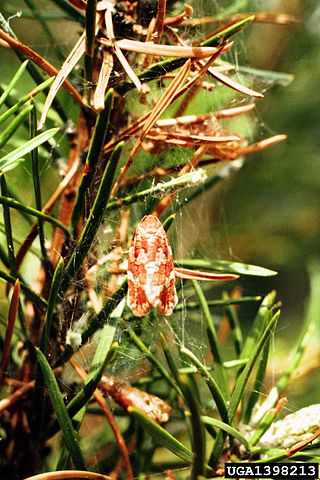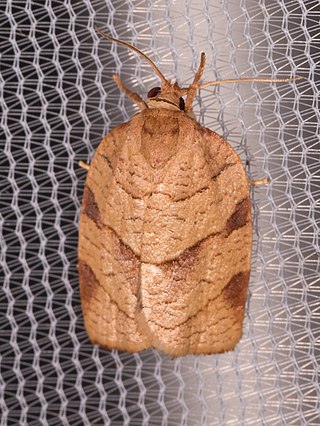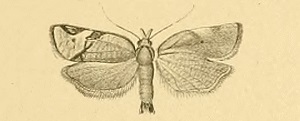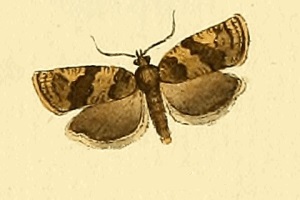
The Tortricidae are a family of moths, commonly known as tortrix moths or leafroller moths, in the order Lepidoptera. This large family has over 11,000 species described, and is the sole member of the superfamily Tortricoidea, although the genus Heliocosma is sometimes placed within this superfamily. Many of these are economically important pests. Olethreutidae is a junior synonym. The typical resting posture is with the wings folded back, producing a rather rounded profile.

Choristoneura occidentalis is a species of moth of the family Tortricidae. It is found in the Democratic Republic of Congo, South Africa, Tanzania and Gambia.

Choristoneura murinana is a moth of the family Tortricidae. It is found in central Europe and the Near East, China, Taiwan and in North America.

Choristoneura pinus, the jack pine budworm, is a moth of the family Tortricidae. The species was first described by Thomas Nesbitt Freeman in 1953. It is found in jack pine forests in Canada from Atlantic provinces to Cypress Hills on the Alberta-Saskatchewan border as well as northern United States from New England to the lake states.
Choristoneura adumbratanus is a species of moth of the family Tortricidae. It is found in Japan, Korea and China.
Choristoneura biennis, the two-year-cycle budworm moth, is a species of moth of the family Tortricidae. It is found in Canada, where it has been recorded from Alberta and British Columbia.
Choristoneura carnana is a species of moth of the family Tortricidae first described by William Barnes and August Busck in 1920. It is found in the United States, where it has been recorded from California and Colorado.
Choristoneura retiniana is a species of moth of the family Tortricidae. It is found in the United States, where it has been recorded from California and Nevada.

Choristoneura obsoletana is a species of moth of the family Tortricidae. It is found in the United States, where it has been recorded from Alabama, Arkansas, California, Florida, Illinois, Kansas, Louisiana, Maine, Massachusetts, Mississippi, Missouri, New Mexico, North Carolina, Ohio, Oklahoma, Oregon, South Carolina, Tennessee, Virginia and West Virginia.

Choristoneura parallela, the parallel-banded leafroller moth, is a species of moth of the family Tortricidae. It is found in North America, where it has been recorded from California, Florida, Georgia, Indiana, Kentucky, Maine, Maryland, Michigan, Mississippi, New Jersey, North Carolina, Ohio, Oklahoma, Quebec, Saskatchewan, South Carolina, Tennessee, Virginia and West Virginia.
Choristoneura zapulata, the zapulata moth, is a moth of the family Tortricidae. The species was first described by Robinson in 1869. It is found in North America, where it has been recorded from British Columbia to Quebec, south to California, Illinois and Pennsylvania.

Choristoneura simonyi is a species of moth of the family Tortricidae. It is found on the Canary Islands.
Choristoneura bracatana is a species of moth of the family Tortricidae. It is found on the Canary Islands.

Choristoneura diversana is a species of moth of the family Tortricidae. It is found in Great Britain, France, Belgium, the Netherlands, Germany, Denmark, Austria, Switzerland, Italy, the Czech Republic, Slovakia, Slovenia, Poland, Bulgaria, Hungary, Romania, Norway, Sweden, Finland, the Baltic region, Russia and the Near East. In the east, the range extends to China (Heilongjiang), Korea and Japan. The habitat consists of gardens, scrub and fens.

Choristoneura lafauryana, the strawberry leafroller, is a species of moth of the family Tortricidae. It is found in Spain, Great Britain, the Netherlands, Belgium, France, Germany, Switzerland, Italy, Romania and Russia. In the east, the range extends to China, Korea and Japan.

Choristoneura evanidana is a species of moth of the family Tortricidae. It is found in the Russian Far East, Korea and China.

Choristoneura longicellanus is a species of moth of the family Tortricidae. It is found in China, Japan, Taiwan, the Korean Peninsula and the Russian Far East.
Choristoneura metasequoiacola is a species of moth of the family Tortricidae. It is found in Hubei, China.
Choristoneura jezoensis is a species of moth of the family Tortricidae. It is found on Hokkaido island in Japan.
Ptycholoma micantana is a species of moth of the family Tortricidae. It is found in China (Heilongjiang), North Korea and Russia. The habitat consists of fir broad-leaved forests, cedar broad-leaved forests and gardens.









